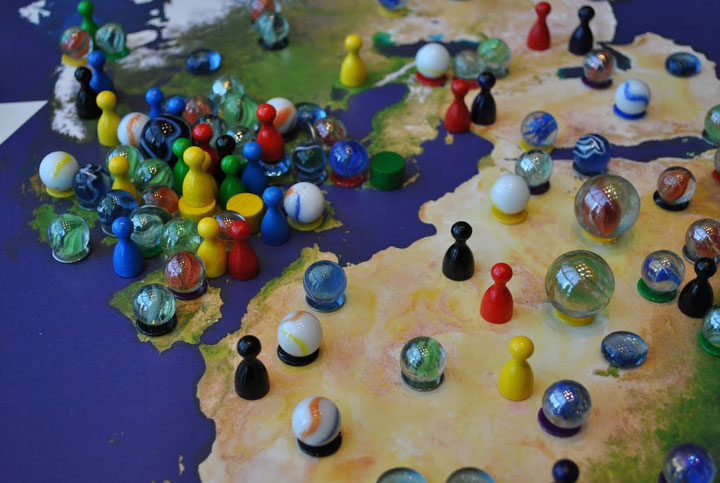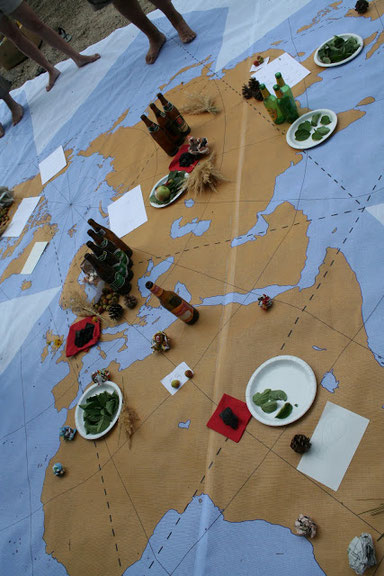Issue 1/2013 - Net section
The World as a Game
In the World Game Lab at the Richard Buckminster Fuller Institute, a more sustainable way of living is being explored.
Richard Buckminster Fuller (1895–1983) was one of the most influential visionaries of the twentieth century. “He was ahead of his time in many aspects. A universally talented man with ingenious ideas: an explorer, inventor, designer, engineer, philosopher, man of letters, college professor, natural scientist, cult icon, philanthropist and world citizen,” as it says on the Richard Buckminster Fuller Institute Austria’s website.1 Thomas Thurner and his colleagues Enrique Guitart and Günther Friesinger developed a fascination with Fuller after reading Your Private Sky, a multifaceted visual primer in which his theories, ideas and projects are comprehensively explored, documented and critically evaluated. Their enthusiasm led to the founding of the RBFI in 2009, a Vienna-based institute that hopes to make Fuller and his work better known in the German-speaking world. The three founders associate Fuller with wacky and interesting projects, and recognize him as a person who brought up topics in the 1960s that are still relevant today. For example, Fuller was already thinking about solutions to the energy crisis, environmental pollution and the destruction of the global ecosystem before anyone else had even mentioned these problems. In 1951 he invented a metaphor comparing the Earth to a spaceship, and later wrote an “instruction manual” for it, admonishing us to take care of the planet. He was a proponent of a networked world, as opposed to a hierarchical one. Fuller’s thought thus also offers for Thurner an attractive historical reference point for the current open data movement, or as Guitart summarizes: “Fuller laid the groundwork for the situation we take for granted nowadays: the fundamental interconnection of the world through computers, satellites and telephones.”2
A Sustainable World-Simulation
By focusing on the World Game, the RBFI chose to look at an aspect of Fuller’s work that combines many of his ideas into one. Although Fuller is best known for his geodesic domes, these are only the visible tip of the iceberg consisting of an extensive body of work in system theory, which is exemplified particularly well in the collective World Game simulation. Initially, the World Game was intended to be used as the USA’s submission to the 1967 World’s Fair in Montreal. While Fuller was allowed to build its outer shell—the Expo pavilion is his most famous “geodome”—the World Game was declined by the US administration. The game was to be the foundation for a cooperative overcoming of global problems. Perhaps the powers-that-be deemed the game too controversial due to its broaching of the energy issue, which was just beginning to gain relevance at the time. In the early version of the game, the visitors enter a geodome to find a giant globe hanging from the ceiling, which is intermittently lowered to the floor, unfolding a gigantic “Dymaxion World Map.” All relevant information about the location and amount of the world’s resources is displayed by computer on the oversize map. This global simulation allows players to develop scenarios focusing on a fair international distribution of resources.
The Game as a Process
In the USA, the World Game as outlined by Fuller gained popularity at several universities towards the end of the 1960s. To this day there are still several varieties of the game in circulation, focusing on different key values. Fuller provides us with few concrete instructions, which is why the RBFI set out to design a playable World Game. While certainly citing Fuller’s thought as a reference, the main focus is to create something that is relevant to the modern day rather than a 1:1 reproduction of the game’s historical format. Thurner also suspects that the steps on the way to developing the game could even be part of the game itself. Therefore, the entire process and the analysis that must be undertaken in its course are the most crucial parts of the entire project, rather than the finished product. Thurner and his team began by building a geodesic dome in order to experience Fuller’s principle of “tensional integrity” (or “tensegrity”), in which continuous tension and intermittent compression share the structure’s load equally between them. Both forces balance each other out, creating a sturdy system, comparable to the spaceship Earth, which Fuller sought to keep on course in the World Game. During an extended symposium, the next important step was determined to be the use of so-called Dymaxion world maps—Fuller’s invention for creating the least warped two-dimensional representation of the world possible. The map allows us to shed light on mutual dependencies and influences independently of nation-states and their borders. When the world is displayed as it is on the Dymaxion map, constructs such as the northern hemisphere or the transatlantic lose their meaning. This unusual presentation encourages novel approaches and perspectives, making it ideal as the foundation of the World Game’s illustration of global resources.
Possible Game Scenarios
The first game featured a walkable Dymaxion map in Lindabrunn in 2012. It was evident there how the World Game visualizes complex details that are selected in order to create a future world that can support all of its inhabitants. This includes the distribution of education, energy and healthcare—areas the players agreed on at the outset. Information regarding these areas was retrieved from online databases and visualized in the form of handmade objects placed on the map. For over eight hours, the players “fought” their way through the game together, until in the end they arrived at an interesting overview of a real-life problem complex and begin to think about more just ways of distributing resources. In a second version of the game at Ars Electronica 2012, the current world situation was to be explained in the space of an hour. Participants were asked to fill out a questionnaire in which they evaluated certain issues in different areas of the world. The data collected was visualized using a computer program. Surprisingly, the result was very close to the Club of Rome’s own prognosis. According to Guitart, people were very surprised at how much they actually know. For him, understanding the relationships between these different aspects is a step in the right direction, towards taking action. At the same time, there is a playful, aesthetic side to the game: the players were able to mark on a Dymaxion world map a place where they would begin to improve the world. This move constitutes a subjective gesture that casts some doubt on the alleged validity of models of data collection that have thus far been developed in science and economics. It follows from this that openness in the sourcing of knowledge is an aspect that is extremely important to the RBFI. In order to gather further findings, the institute holds regular public meet-ups.
Translated by Jennifer Taylor
1 www.worldgamelab.org
2 Enrique Guitart in the foreword to the publication How to Make the World Work, published on the occasion of the symposium Richard Buckminster Fuller World Game Lab (October 14–15, 2011). All further quotes come from telephone interviews that were held on November 7, 2012, with Thomas Thurner and on November 15, 2012, with Enrique Guitart.

